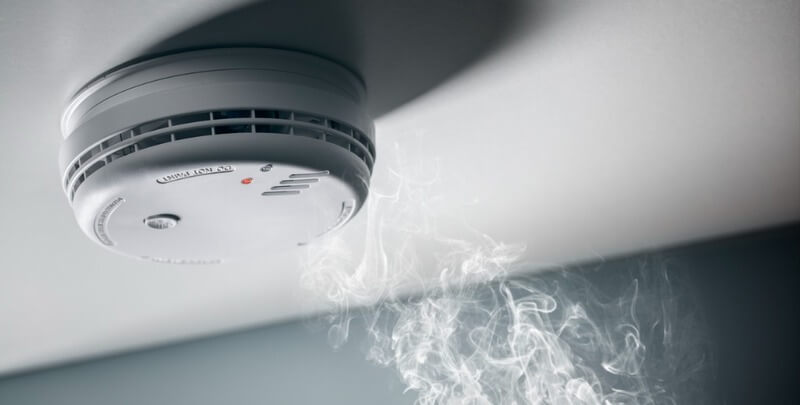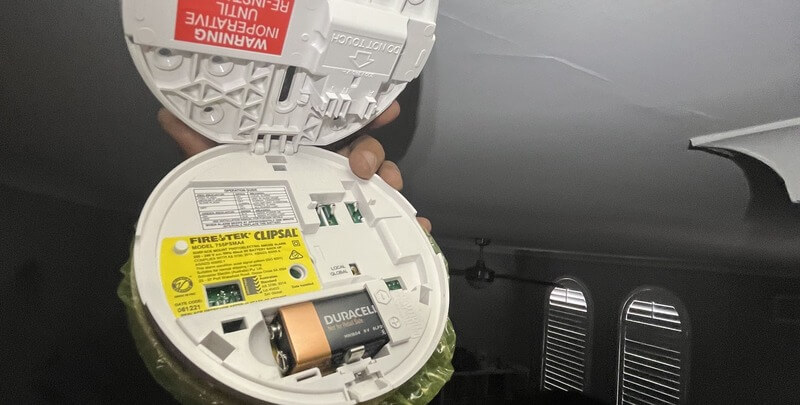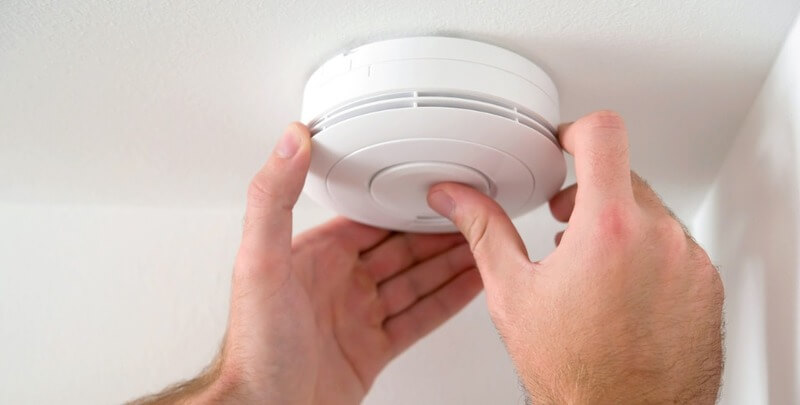Is There a Difference Between a Smoke Alarm and a Smoke Detector?

Imagine you're at home and suddenly detect the acrid smell of smoke. Your heart races as you search for the source. In such moments, you rely on devices that could be the difference between life and disaster – smoke alarms and smoke detectors.
People often consider these lifesaving devices the same, but critical differences set them apart. In this article, we’re going to clear the air, quite literally, and help you understand the distinction between smoke alarms and smoke detectors.
By the time you’ve finished reading, you’ll have a clearer picture of how these devices work, their unique features, and when and where you should use each.
Before we dive into the specifics, let’s first acknowledge the shared importance of these devices in safeguarding your home and loved ones from the devastating effects of a fire. Early detection can make all the difference, whether a raging inferno or a small tiny fire.
Let’s explore the fascinating world of smoke alarms and smoke detectors to see how they play distinct roles in fire safety.
Understanding Smoke Alarms
To fully grasp the nuances of smoke alarms, it’s essential to understand their definition, primary purpose, the various types available, and how they operate.
Smoke alarms, often colloquially referred to as smoke detectors, are standalone devices designed to detect the presence of smoke or combustion particles in the air. Their primary purpose is to provide an immediate local alert during a fire. The fundamental goal of a smoke alarm is to awaken and alert the occupants of a building to the danger, enabling them to evacuate in a timely and safe manner.
Different Types of Smoke Alarms
- Ionisation smoke alarms: These smoke alarms are highly sensitive to fast-burning fires, such as those ignited by flammable liquids or paper. They work based on ionisation technology, which involves a small amount of radioactive material. This radioactive material ionises the air within a chamber, creating an electrical current. When smoke particles disrupt this current, the alarm is triggered.
- Photoelectric smoke alarms: On the other hand, photoelectric smoke alarms are better at detecting slow, smouldering fires, like those caused by overheated wiring. They employ a different technology, which includes a light source and a photosensitive sensor. When smoke particles scatter the light, it triggers the alarm.
- Dual-sensor smoke alarms: Some smoke alarms combine both ionisation and photoelectric technologies. These dual-sensor alarms provide comprehensive fire detection, making them suitable for various types of fires. They offer a well-rounded approach to fire safety.
How Smoke Alarms Work and Their Components
Smoke alarms consist of several key components working in harmony to detect and alert you to the presence of smoke:
- Sensor: The sensor is the heart of the smoke alarm. It’s the component responsible for detecting smoke particles in the air. The type of sensor used, whether ionisation or photoelectric, determines the alarm’s sensitivity to different types of fires.
- Alarm sounder (siren): When the sensor detects smoke, it triggers the alarm sounder, which produces a loud, piercing sound. Designers have crafted this sound to grab your attention and remain audible even when sleeping.
- Power source: Either batteries or hardwired electrical connections power smoke alarms. Battery-operated alarms are easy to install but require regular battery replacement. Hardwired alarms are connected to your home’s electrical system and often have a battery backup in case of power failures.
Understanding how smoke alarms operate is the first step in appreciating their critical role in fire safety. However, knowing how to install and maintain them properly and recognising their legal requirements will further enhance your understanding and ensure your home is well-protected.

Understanding Smoke Detectors
Smoke detectors are essential elements of fire alarm systems. They designed them to sense the presence of smoke and initiate a broader alert, often connecting to a central monitoring system.
Like smoke alarms, there are different types of smoke detectors, each with unique capabilities.
- Ionisation smoke detectors: These work similarly to ionisation smoke alarms and are suitable for quickly spreading fires. They create an electric current and sound an alarm when smoke particles disrupt it.
- Photoelectric smoke detectors: These detectors efficiently sense smouldering fires like photoelectric smoke alarms. When smoke particles scatter the light beam within the sensor, it triggers the alarm.
- Heat detectors: Instead of smoke, heat detectors respond to temperature changes. Typically, people install them where dust and fumes might trigger false alarms.
- Air-sampling smoke detectors: These advanced detectors use air-sampling technology to detect minuscule particles, providing early warning in critical environments.
Smoke detectors typically consist of sensors, an alarm sounder, a control panel, and a power source. They are often interconnected, enabling multiple units to communicate and sound the alarm in unison.
Key Differences Between the Two
Now that we have a solid understanding of smoke alarms, let’s delve into the primary differences between smoke alarms and smoke detectors.
These differences are crucial in determining which device is best suited for your specific needs and the fire safety requirements of your building.
Functionality
- Smoke alarms: Smoke alarms are standalone devices designed to detect the presence of smoke and, upon detection, raise the alarm within the immediate vicinity. They install and provide a localised alert within the building.
- Smoke detectors: In contrast, smoke detectors are components of more extensive fire alarm systems. Designers have created them to sense smoke presence and initiate a broader alert, including notifying a central monitoring station. These alarms are typically interconnected to provide a coordinated response across various building areas.
Alert Type
- Smoke alarms: Smoke alarms generally emit an audible alert within the building where they are installed. To produce a loud and attention-grabbing sound, immediately notify the occupants of the smoke.
- Smoke detectors: As part of larger fire alarm systems, smoke detectors can trigger alarms inside and outside the building. They can often alert emergency services, such as the fire department and those inside the building.
Applications
- Smoke alarms: People typically use smoke alarms in residential settings, such as homes and apartments, to provide immediate alerts to the occupants, allowing them to take prompt action in case of a fire.
- Smoke detectors: Smoke detectors find their primary application in commercial and industrial settings. These environments require a more comprehensive and interconnected fire alert system. Early detection and a coordinated response are critical to mitigating fire risks in industrial settings.
Interconnectivity
- Smoke alarms: Smoke alarms in residential settings are often standalone, meaning they do not communicate. Each alarm functions independently, raising an alert only in its immediate vicinity.
- Smoke detectors: Smoke detectors in commercial and industrial settings typically interconnect. It means they can communicate with one another and work in unison. When one sensor detects smoke, it triggers the alarms on all interconnected units, creating a synchronised response.
Response to Fire Types
- Smoke alarms: Smoke alarms are typically better suited for specific types of fires. For example, ionisation alarms are highly sensitive to fast-burning fires, while photoelectric smoke alarms detect slow, smouldering fires more effectively.
- Smoke detectors: Smoke detectors, particularly in commercial and industrial settings, are versatile in detecting various types of fires. Designers create them to offer early warnings in complex environments where fire hazards may exist.
Understanding these critical differences between smoke alarms and smoke detectors is crucial when determining which device suits your needs. By selecting the most suitable machine, you can significantly enhance the fire safety measures in your home or business.

Installation and Maintenance
Installing and maintaining smoke alarms and smoke detectors is paramount to ensuring their effectiveness in protecting your home from fires. Let’s follow a step-by-step guide to help you set up these devices and keep them working correctly.
- Identify suitable locations: Identify suitable locations for your smoke alarms or detectors. Follow the manufacturer’s guidelines for proper placement. These guidelines are essential to ensure optimal performance.
- Mounting: Install ceiling-mounted devices in the centre of the ceiling, maintaining at least four inches of clearance from the nearest wall. If you’re installing them on the wall, place them high, 10cm to 30cm (4 to 12 inches) below the ceiling. Avoid corners and areas with solid airflow, as these can affect their performance.
- Power source: If you have hardwired smoke alarms, connect them to your electrical system following the manufacturer’s instructions. For battery-operated models, install fresh batteries according to the manufacturer’s recommendations. Ensure that you insert the batteries correctly.
- Testing after installation: Once you’ve installed your smoke alarms or detectors, you must test each unit immediately to confirm they function correctly. When pressed, most devices have a test button that will sound the alarm briefly for you to verify that it’s operational.
Tips for Proper Placement
- In sleeping areas: Install smoke alarms in every sleeping area of your home. It ensures that everyone in your household is alerted if a fire occurs at night.
- On each level: Place smoke alarms on every level of your home, including the basement. Fires can start on any floor, and having alarms on each level provides comprehensive coverage.
- Away from cooking appliances: To reduce false alarms, position smoke alarms at least 3m (10 feet) away from cooking appliances like stoves and ovens. It prevents alarms from being triggered by cooking-related smoke or fumes.
- Kitchens: In the kitchen, where cooking activities can sometimes create smoke, consider using heat detectors instead of smoke alarms or a combination of heat and smoke detectors. Heat detectors respond to temperature changes rather than smoke, reducing false alarms.
Maintenance and Testing Procedures
Proper maintenance ensures that your smoke alarms and detectors continue to work effectively. Here are essential maintenance and testing procedures to follow:
- Monthly testing: Press the test button to test your smoke alarms and detectors at least once a month. When you do this, the notice should sound brief, indicating that it’s functioning as expected.
- Battery replacement: If you have battery-operated smoke alarms or detectors, replace the batteries at least once a year or as the manufacturer recommends. As a reminder, it’s a good practice to do this when you change your clocks for daylight saving time.
- Cleaning: Clean your devices regularly to prevent dust and debris buildup. Dust and dirt can interfere with their functionality. Use a soft brush or a vacuum cleaner with a nozzle attachment to remove particles from the vents and sensors.
By following these installation and maintenance guidelines, you can ensure that your smoke alarms and detectors are always ready to provide early warning in the event of a fire, giving you and your loved ones the best chance to stay safe. Fire safety is a shared responsibility; your proactive measures can make a significant difference.
Legal Requirements and Building Codes
The legal requirements for smoke alarms and detectors vary by region and building type. Compliance with building codes and regulations is of utmost importance. Failing to do so can result in severe consequences in a fire. Ensure you:
- Check your local building codes to determine the specific requirements for your area.
- Install the appropriate type and number of devices as mandated.
- Regularly inspect and maintain your alarms or detectors to remain compliant.
Cost Comparison
Understanding the costs associated with smoke alarms and smoke detectors is crucial when deciding which fire safety devices to install in your home or business.
Let’s break down the costs and consider the factors that influence these expenses, including long-term considerations.
- Smoke alarms: Smoke alarms are generally more budget-friendly and readily available at your local hardware store or online retailers. They are designed with residential use in mind and are thus cost-effective for homeowners.
- Smoke detectors: Smoke detectors, especially those intended for commercial or industrial use, can be pricier. This higher cost is often due to the need for more advanced features, connectivity to central monitoring systems, and the ability to function in larger, more complex environments.
Factors Influencing Price
Several factors can influence the price of both smoke alarms and smoke detectors:
- Type and features: The specific type of device you choose, whether it’s an ionisation, photoelectric, heat, or air-sampling detector, will impact the cost. More advanced features, such as wireless connectivity or advanced sensor technology, can also increase the price.
- Number of units required: The number of devices you need for your space significantly affects the total cost. Larger homes or commercial buildings will require more units, which can quickly add to the expense.
- Installation and wiring costs: Smoke detectors, especially those used in commercial settings, often require professional installation and wiring, increasing the overall cost. It contrasts smoke alarms, which are typically easier to install and might not need professional assistance.
Long-Term Cost Considerations
While the upfront cost is an important consideration, it’s equally essential to think about the long-term costs of maintaining and operating these devices:
- Smoke alarms: While smoke alarms are generally cheaper upfront, homeowners should factor in the cost of battery replacement and regular maintenance. You must change the batteries at least once a year or as the manufacturer recommends. Over the years, these costs can accumulate.
- Smoke detectors: While more expensive initially, commercial smoke detectors often come with comprehensive service and maintenance contracts. In the long run, these contracts can save costs, including regular inspections, battery replacements, and troubleshooting. Additionally, commercial systems are typically hardwired, reducing the need for frequent battery changes.
In summary, while the initial investment for smoke detectors may be higher, they offer a robust and comprehensive solution, especially for commercial or industrial environments. The long-term cost considerations make them viable and cost-effective for such settings.
However, smoke alarms can provide adequate fire protection at a lower upfront cost for smaller residential spaces, although homeowners should budget for ongoing maintenance. Ultimately, the choice should align with your home or business’s requirements and budget.

Choosing the Right Device
Selecting the appropriate fire safety device, whether a smoke alarm or a smoke detector, depends on several factors. The choice should align with your specific circumstances and the unique needs of your building.
Let’s explore the key considerations, real-world scenarios, and recommendations to help you make an informed decision.
Factors to consider include:
- Type of building: Consider the type of building you are equipping with fire safety devices. Is it a residential home, a commercial space, or an industrial facility? Different settings have distinct requirements for fire safety.
- Fire risks: Assess the fire risks associated with the building and its contents. Some environments may be more prone to certain types of fires, such as those caused by flammable materials or electrical faults.
- Budget and maintenance: Evaluate your budget and long-term maintenance capabilities. Consider the initial cost of the devices and the ongoing maintenance and battery replacement expenses.
Real-World Scenarios and Recommendations
Let’s explore specific scenarios and recommendations based on different building types:
For a typical home:
- Recommend using a combination of ionisation and photoelectric smoke alarms in residential settings. This combination provides comprehensive protection against a variety of fire types. Ionisation alarms are highly sensitive to fast-burning fires, while photoelectric alarms excel at detecting slow, smouldering fires. Having both types of alarms ensures early detection for different fire scenarios.
- Additionally, make sure to install smoke alarms in every sleeping area and on each level of your home. It provides optimal coverage, ensuring everyone in the house is alerted during a fire. Regular maintenance, such as monthly testing and annual battery replacement, is essential.
For industrial settings:
- In industrial settings where the fire risks can be more diverse and complex, interconnected smoke detectors with central monitoring offer the highest level of safety. These detectors are often part of comprehensive fire alarm systems that can automatically alert authorities, initiate evacuation procedures, and provide real-time information to first responders.
- Designers create such systems to address the unique challenges of industrial environments, where large spaces, diverse fire hazards, and the need for immediate response are critical. Maintenance is typically handled through service contracts, ensuring the system is always in peak condition.
Remember, it’s always wise to consult with a fire safety professional who specialises in fire safety systems. These experts can provide tailored recommendations based on your unique needs, taking into account the specific characteristics of your building and the fire risks associated with it.
They can also assist with the proper installation, maintenance, and compliance with local fire safety regulations, ensuring the highest level of protection for your property and the people within it. Making the right choice in fire safety devices can significantly mitigate fire risks.
Understanding the Difference
Regarding fire safety, knowledge is the key to adequate protection. Although often used interchangeably, smoke alarms and smoke detectors play distinct roles and offer unique features that cater to various settings and requirements.
By understanding the differences between these devices, you can make informed choices that enhance the safety of your home or business. Whether outfitting a residential space with cost-effective smoke alarms or equipping an industrial facility with advanced interconnected smoke detectors, the right choice can make all the difference in safeguarding lives and property.
Moreover, compliance with legal requirements and building codes ensures you meet the highest safety standards, reducing risks and potential liabilities.
Remember, installing, maintaining, and regularly testing these devices are optional – still critical components of fire safety. You should always notice investments in your protection, such as proper placement, battery replacement, and routine cleaning, which entail proactive measures.
In a world where the unexpected can happen at any time, prioritising fire safety is a choice that can save lives and property. It’s a choice that matters when it matters most.
So, take action, make informed decisions, and ensure that your home or business is well-prepared to face the unexpected because preparedness is paramount regarding fire safety.
Please note: This information is provided for advice purposes only. Regulations differ from state to state, so please consult your local authorities or an industry professional before proceeding with any work. See After Hours Electrical’s Terms & Conditions here.